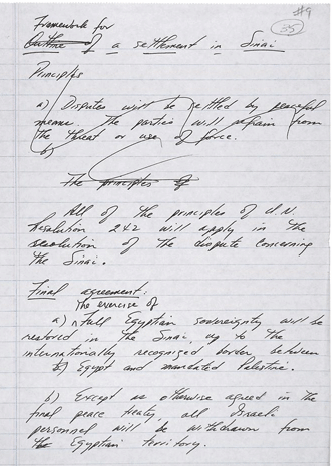Camp David Negotiations: Draft Framework for a Settlement in the Sinai
(September 1978)
 |
In order to achieve peace between them, Israel and Egypt agree to negotiate in good faith with a goal of concluding within three months of the signing of this framework a peace treaty between them. [There are no preconditions to the commencement of the negotiations.]
All of the principles of U.N. Resolution 242 will apply in this resolution of the dispute between Israel and Egypt.
Peace Treaty
Unless otherwise mutually agreed, terms of the peace treaty will be implemented between two and three years after the peace treaty is signed.
In the peace treaty, the issues of: a)the full exercise of Egyptian sovereignty up to internationally recognized border between Egypt and mandated Palestine; b) the time of withdrawal of Israeli personnel from the Sinai; c) the [civilian] use of airfields [at] near El Arish, Eitam, Etzion, and Ofir,* for civilian purposes only; d) the right of free passage by ships of Israel and other nations through the Strait of Tiran, the Gulf of Suez and the Suez Canal; e) the Construction of an international highway between the Sinai and Jordan near Elat; and f) the [reduction] stationing of military [threats against Israel and Egypt by the steps] listed below (will be resolved by negotiations between the parties).
Stationing of Forces
--Within an area lying approximately 50 kilometers (km) east of the gulf of Suez and the Suez Canal, no more than one division of Egyptian mechanized or infantry armed forces will be stationed. [No strike]
--Only United Nations forces and civil police equipped with light weapons to perform normal police functions will be stationed. lying west of in the area not included above, border patrol units, not to exceed three battalions, will supplement the civil police in maintaining order.
The exact demarcation of the above areas will be as mutually agreed during the peace negotiations.
Early warning stations may [remain or be established] exist as mutually agreed to insure compliance with the terms of the agreement.
United Nations forces will be stationed in the Sharm el Sheikh area to insure freedom of passage through the Straits of Tiran, and will be removed only if [both nations agree and after] such agreement is approved by the Security Council of the United Nations.
Normal relations will be established between Egypt and Israel, including: full recognition; [diplomatic, economic, and cultural relations;] termination of economic boycotts [and barriers to the free movement of goods and people]; and mutual protection of citizens by the due process of law.
Interim Withdrawal
Between [six] three months and nine months after signing of the peace treaty, all Israeli forces will withdraw [to] east of a line extending from a point [just] east of El Arish to Ras Muhammad, the exact location of this line to be determined by mutual agreement.
Sources: Camp David Accords — Framework for Peace; U.S. National Archives
Text noted in bracketted [italics] represents elements Carter drafted and then struck out.
* At this point in the draft, the President inserted the following above the line of airports: [El Airsh] [Rafah] [Ras en Nagb] [Sharm el Sheikh]


